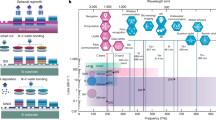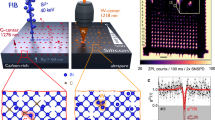Abstract
The integration of optical interconnects with silicon-based electronics can address the growing limitations facing chip-scale data transport as microprocessors become progressively faster. However, until now, material lattice mismatch and incompatible growth temperatures have fundamentally limited monolithic integration of lasers onto silicon substrates. Here, we use a novel growth scheme to overcome this roadblock and directly grow on-chip InGaAs nanopillar lasers, demonstrating the potency of bottom-up nano-optoelectronic integration. Unique helically propagating cavity modes are used to strongly confine light within subwavelength nanopillars despite the low refractive index contrast between InGaAs and silicon. These modes therefore provide an avenue for engineering on-chip nanophotonic devices such as lasers. Nanopillar lasers are as-grown on silicon, offer tiny footprints and scalability, and are thus particularly suited to high-density optoelectronics. They may ultimately form the basis of future monolithic light sources needed to bridge the existing gap between photonic and electronic circuits.
This is a preview of subscription content, access via your institution
Access options
Subscribe to this journal
Receive 12 print issues and online access
$209.00 per year
only $17.42 per issue
Buy this article
- Purchase on Springer Link
- Instant access to full article PDF
Prices may be subject to local taxes which are calculated during checkout





Similar content being viewed by others
References
Maiman, T. H. Stimulated optical radiation in ruby. Nature 187, 493–494 (1960).
Miller, D. A. B. Device requirements for optical interconnects to silicon chips. Proc. IEEE 97, 1166–1185 (2009).
Chen, G. et al. Predictions of CMOS compatible on-chip optical interconnect. Integr. VLSI J. 40, 434–446 (2007).
Cloutier, S. G., Kossyrev, P. A. & Xu, J. Optical gain and stimulated emission in periodic nanopatterned crystalline silicon. Nature Mater. 4, 887–891 (2005).
Pavesi, L., Dal Negro, L., Mazzoleni, C., Franzo, G. & Priolo, F. Optical gain in silicon nanocrystals. Nature 408, 440–444 (2000).
Liu, J., Sun, X., Camacho-Aguilera, R., Kimerling, L. C. & Michel, J. Ge-on-Si laser operating at room temperature. Opt. Lett. 35, 679–681 (2010).
Rong, H. et al. An all-silicon Raman laser. Nature 433, 292–294 (2005).
Rong, H. et al. A continuous-wave Raman silicon laser. Nature 433, 725–728 (2005).
Boyraz, O. & Jalali, B. Demonstration of a silicon Raman laser. Opt. Express 12, 5269–5273 (2004).
Fang, A. W. et al. Electrically pumped hybrid AlGaInAs–silicon evanescent laser. Opt. Express 14, 9203–9210 (2006).
Van Campenhout, J. et al. Electrically pumped InP-based microdisk lasers integrated with a nanophotonic silicon-on-insulator waveguide circuit. Opt. Express 15, 6744–6749 (2007).
Lo, Y. H., Bhat, R., Hwang, D. M., Chua, C. & Lin, C.-H. Semiconductor lasers on Si substrates using the technology of bonding by atomic rearrangement. Appl. Phys. Lett. 62, 1038–1040 (1993).
Chen, H. Z., Ghaffari, A., Wang, H., Morkoc, H. & Yariv, A. Low-threshold (∼600 A/cm2 at room temperature) GaAs/AlGaAs lasers on Si (100). Appl. Phys. Lett. 51, 1320–1321 (1987).
Groenert, M. E. et al. Monolithic integration of room-temperature cw GaAs/AlGaAs lasers on Si substrates via relaxed graded GeSi buffer layers. J. Appl. Phys. 93, 362–367 (2003).
Ujiie, Y. & Nishinaga, T. Epitaxial lateral overgrowth of GaAs on a Si Substrate. Jpn J. Appl. Phys. 28, L337–L339 (1989).
Olsson, F., Xie, M., Lourdudoss, S., Prieto, I. & Postigo, P. A. Epitaxial lateral overgrowth of InP on Si from nano-openings: theoretical and experimental indication for defect filtering throughout the grown layer. J. Appl. Phys. 104, 093112 (2008).
Moewe, M., Chuang, L. C., Crankshaw, S., Chase, C. & Chang-Hasnain, C. Atomically sharp catalyst-free wurtzite GaAs/AlGaAs nanoneedles grown on silicon. Appl. Phys. Lett. 93, 023116 (2008).
Moewe, M., Chuang, L. C., Crankshaw, S., Ng, K. W. & Chang-Hasnain, C. Core–shell InGaAs/GaAs quantum well nanoneedles grown on silicon with silicon-transparent emission. Opt. Express 17, 7831–7836 (2009).
Chen, R. et al. Second-harmonic generation from a single wurtzite GaAs nanoneedle. Appl. Phys. Lett. 96, 051110 (2010).
Chuang, L. C. et al. InGaAs QW nanopillar light emitting diodes monolithically grown on a Si substrate. Conference on Lasers and Electro-Optics, CMFF6 (OSA, 2010).
Chuang, S. L. Physics of Optoelectronic Devices 337–393 (Wiley, 1995).
Coldren, L. A. & Corzine, S. W. Diode Lasers and Photonic Integrated Circuits 185–261 (Wiley, 1995).
Baba, T. Photonic crystals and microdisk cavities based on GaInAsP-InP system. IEEE J. Sel. Top. Quant. Electron. 3, 808–830 (1997).
Bjork, G. & Yamamoto, Y. Analysis of semiconductor microcavity lasers using rate equations. IEEE J. Quant. Electron. 27, 2386–2396 (1991).
McCall, S. L., Levi, A. F. J., Slusher, R. E., Pearton, S. J. & Logan, R. A. Whispering-gallery mode microdisk lasers. Appl. Phys. Lett. 60, 289–291 (1992).
Nobis, T. & Grundmann, M. Low-order optical whispering-gallery modes in hexagonal nanocavities. Phys. Rev. A 72, 063806 (2005).
Wiersig, J. Hexagonal dielectric resonators and microcrystal lasers. Phys. Rev. A 67, 023807 (2003).
Chen, R., Chuang, L. C., Tran, T., Moewe, M. & Chang-Hasnain, C. Spatially resolved, polarized photoluminescence from wurtzite InGaAs/GaAs nanoneedles. Conference on Lasers and Electro-Optics, JWA95 (OSA, 2010).
Hill, M. T. et al. Lasing in metallic-coated nanocavities. Nature Photon. 1, 589–594 (2007).
Oulton, R. F. et al. Plasmon lasers at deep subwavelength scale. Nature 461, 629–632 (2009).
Hill, M. T. et al. Lasing in metal-insulator-metal sub-wavelength plasmonic waveguides. Opt. Express 17, 11107–11112 (2009).
Nezhad, M. P. et al. Room-temperature subwavelength metallo-dielectric lasers. Nature Photon. 4, 395–399 (2010).
Yu, K., Lakhani, A. & Wu, M. C. Subwavelength metal–optic semiconductor nanopatch lasers. Opt. Express 18, 8790–8799 (2010).
Kuykendall, T., Ulrich, P., Aloni, S. & Yang, P. Complete composition tunability of InGaN nanowires using a combinatorial approach. Nature Mater. 6, 951–956 (2007).
Qian, F. et al. Multi-quantum-well nanowire heterostructures for wavelength-controlled lasers. Nature Mater. 7, 701–706 (2008).
Pan, A. et al. Continuous alloy-composition spatial grading and superbroad wavelength-tunable nanowire lasers on a single chip. Nano Lett. 9, 784–788 (2009).
Kawachi, M. Silica waveguides on silicon and their application to integrated-optic components. Opt. Quant. Electron. 22, 391–416 (1990).
Suzuki, S., Shuto, K. & Hibino, Y. Integrated-optic ring resonators with two stacked layers of silica waveguide on Si. IEEE Photon. Tech. Lett. 4, 1256–1258 (1992).
Bogaerts, W. et al. Nanophotonic waveguides in silicon-on-insulator fabricated with CMOS technology. J. Lightwave Technol. 23, 401–412 (2005).
Ando, S., Kobayashi, N. & Ando, H. Hexagonal-facet laser with optical waveguides grown by selective area metalorganic chemical vapor deposition. Jpn J. Appl. Phys. 34, L4–L6 (1995).
Choi, S. J., Djordjev, K., Choi, S. J. & Dapkus, P. D. Microdisk lasers vertically coupled to output waveguides. IEEE Photon. Tech. Lett. 15, 1330–1332 (2003).
Taillaert, D. et al. An out-of-plane grating coupler for efficient butt-coupling between compact planar waveguides and single-mode fibers. IEEE J. Quant. Electron. 38, 949–955 (2002).
Mahler, L. et al. Vertically emitting microdisk lasers. Nature Photon. 3, 46–49 (2009).
Koseki, S., Zhang, B., De Greve, K. & Yamamoto, Y. Monolithic integration of quantum dot containing microdisk microcavities coupled to air-suspended waveguides. Appl. Phys. Lett. 94, 051110 (2009).
Acknowledgements
This work was supported by the Defense Advanced Research Projects Agency (DARPA) University Photonics Research (UPR) Award HR0011-04-1-0040, Microelectronics Advanced Research Corp (MARCO) Interconnect Focus Center (IFC) and the Department of Defense (DoD) National Security Science and Engineering Faculty Fellowship. C.C.H. acknowledges support from the Chang Jiang Scholar Endowed Chair Professorship at Tsinghua University, China, and the Li Ka Shing Foundation Women in Science Research Grants. R.C. acknowledges support from a National Defense Science and Engineering Graduate Fellowship. The authors thank Cun-Zheng Ning and E.K. Lau for fruitful discussions.
Author information
Authors and Affiliations
Contributions
C.C.H. proposed and guided the overall project. R.C., T.-T.D.T, K.W.N. and C.C.H. designed the experiments. R.C. and T.-T.D.T. performed optical measurements. K.W.N., W.S.K. and L.C.C. developed and performed material growth. K.W.N. and W.S.K. performed SEM measurements. R.C., T.-T.D.T. and F.G.S. studied and simulated the optical mode. R.C. performed gain modelling and rate equation analysis. R.C. and C.C.H. composed the manuscript.
Corresponding author
Ethics declarations
Competing interests
The authors declare no competing financial interests.
Supplementary information
Rights and permissions
About this article
Cite this article
Chen, R., Tran, TT., Ng, K. et al. Nanolasers grown on silicon. Nature Photon 5, 170–175 (2011). https://doi.org/10.1038/nphoton.2010.315
Received:
Accepted:
Published:
Issue Date:
DOI: https://doi.org/10.1038/nphoton.2010.315
This article is cited by
-
Short-wave infrared cavity resonances in a single GeSn nanowire
Nature Communications (2023)
-
Improved Sensitivity of a Sensor Based on Metallic Nano-cylinder Coated with Graphene
Plasmonics (2023)
-
Highly efficient nonlinear optical emission from a subwavelength crystalline silicon cuboid mediated by supercavity mode
Nature Communications (2022)
-
Observation of polarity-switchable photoconductivity in III-nitride/MoSx core-shell nanowires
Light: Science & Applications (2022)
-
Bowing-alleviated continuous bandgap engineering of wafer-scale WS2xSe2(1-x) monolayer alloys and their assembly into hetero-multilayers
NPG Asia Materials (2022)



